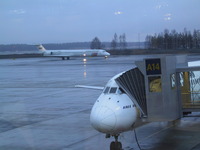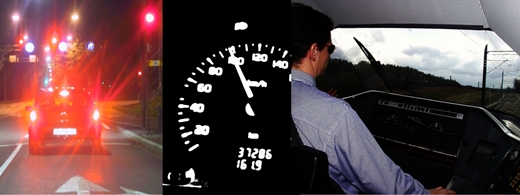Technical advances to improve work operations may increase task monotony and make the problem worse still. The future implications for transport operations across sectors are serious. Findings from research across sectors give cause for concern.
 |
| Accident analyses ascribe fatigue as a primary cause of between 13 and 40 per cent of truck crashes. |
Road sector
In the road sector several studies confirm the high prevalence of fatigue among different types of occupational driver (Feyer and Williamson 2000; Barr et al. 2005), and accident analyses ascribe fatigue as a primary cause of between 13 and 40 per cent of truck crashes (Hartley 2007; Craft 2009).
Train accidents
In the rail industry, independent studies of near accidents agree that ca.17 per cent of train accidents are related to fatigue at work (Härmä et al., 2002).
Maritime Sector
In the maritime sector, accumulative sleep deficit and sustained mental demand in monotonous conditions present a particular challenge.
Recent studies confirm that seafarers are often fatigued while they work (Härmä et al., 2008; Gander et al., 2005). Accident analyses have found that fatigue contributes to 16% of critical vessel accidents and 33% of personal injuries (Raby and Lee, 2001).
Airline sector
Fatigue among airline crew is relatively well regulated, but here accumulative sleep deficit is still seen as a growing problem, which will only be exacerbated by ultra-long range flights (Caldwell, Mallis, et al., 2009).
A recent survey among Norwegian airline pilots revealed that 50% reported that they had fallen asleep in the cockpit, and nine out of ten have felt so fatigued that they did not consider themselves fit for flying (NRK, 2010). Of particular concern in the aviation sector is the effect of fatigue on the vigilance and monitoring performance of airport security staff.
 |
| A recent survey among Norwegian airline pilots revealed that 50% reported that they had fallen asleep in the cockpit, and nine out of ten have felt so fatigued that they did not consider themselves fit for flying. |
A large proportion of the work of airport security staff consists of highly monotonous screening tasks, checking X-ray images for dangerous items in the passengers’ luggage. While fatigue generally decreases the performance in such tasks, the low prevalence of dangerous items is another factor that implicates a high risk for overlooking some of them (Elias, 2008; Wolfe et al., 2007).
Increased focus on legislation
The need to address fatigue as a threat to safe transport is recognized increasingly by regulators. However, there is wide agreement that regulatory approaches based on hours of service could be improved substantially. The current Drivers’ Hours Rules Directive applying to commercial drivers in EEA countries, is typical in that it limits hours per shift, hours per week and sets out minimum length break times (Gander et al., 2010). Such legislation fails to account for circadian effects (Moore-Ede, Heitmann et al., 2005), chronic fatigue or individual differences (Phillips & Sagberg, 2010). There is evidence that the rules are interpreted loosely and rarely enforced vigorously.
Research in Australia and the US shows that similar legislation there has no demonstrable effect on fatigue outcomes (Poore and Hartley, 1998; Haworth, 1998; NTC, 2000). At sea the International Maritime Organisation (IMO) attempted to improve the extent to which hours of service legislation account for fatigue in 1995, but the rules accounted inadequately for the causes of fatigue, and economic factors and crew downsizing have led to lean interpretation and enforcement of the rules (Kristiansen 2001; Unknown 2006).
Guidance
The IMO issued guidance, rather than regulation, on fatigue management in 2001, but little is known about how or even whether this guidance is used. The main regulatory approach on the railways is also hours of service, and the prevalence of fatigue among drivers suggests that it could be improved (Gertler and Raslaer 2009).
In airport security, it is common that screeners are rotated to different tasks every 20 minutes in order to avoid reduced performance due to long time-on-task (Wolfe et al., 2007), an approach that is only of limited use in other transportation tasks, such as truck or engine-drivers. Given the above challenges there have been attempts to place the onus for responsibility for management of fatigue from regulatory authorities to individual organizations, which may more effectively select suitable, complementary measures to tackle fatigue, and monitor its outcomes (Phillips & Sagberg, 2010).
Fatigue Management Programme
This so-called “Fatigue Management Programme (FMP)” approach sensibly allows authorities to emphasise fatigue outcome limits rather than hours of service. The approach was first pioneered in Australia where fleets were granted relief from prescriptive hours of service regulation in return for demonstrating a comprehensive programme to prevent fatigue (Mahon 1998), an approach recently nationalized in the form of the Heavy Vehicle Driver Fatigue reform (Gander et al. 2010). Typical measures in an FMP include informed scheduling, driver and management training, and health screening of drivers (Phillips and Sagberg 2010a).
A parallel approach to improving fatigue regulation, also initiated in Australia, is to prescribe that fatigue be managed in the same way as more traditional workplace hazards such as chemicals or manual handling, although because of its systemic complexity comprehensive fatigue risk management systems are encouraged (Queensland:Government 2010).
Organization
Again, the onus for fatigue management is placed on the transport organization. Pioneering work in Australia and North America has begun to stimulate international changes in fatigue regulation. Rapid progress has also been made in the international air sector. In 2005 easyJet, through documentation of its FRMS approach, became the first UK airline company to be granted exemption from the Civil Aviation Authority’s Flight Time Limitations (Stewart et al. 2006).
More recently, the European Aviation Safety Agency made FMPs a requirement for airlines with operations in Europe. Also recently, the Federal Rail Safety Act made FMPs mandatory on US railroads (Moore-Ede 2010). Despite these developments, only a handful of jurisdictions currently accept FMPs directly as an integral part of safety regulation, and most relate to the governance of aviation (Dawson et al. 2010).
Best current policy governing road, rail and sea transport companies in EEA countries simply delineates approved shift pattern standards and durations, and dictates that organisational rosters should be checked against these standards for any unapproved patterns. This approach still fails to account for several major influences on fatigue (Dawson and McCulloch 2005).
Monotony of the job task
One aspect of FMPs rarely considered to date, is whether by considering also the monotony of the job task they would also help organisations manage the risk of reduced vigilance occurring among transport workers operating in safety- and security-critical situations. A recent ERA-NET report concluded that in order stimulate a broader uptake of FMPs by transport organisations, there is a need for knowledge about measures best suited to different situations, about how organisations should account for existing culture, roles and operations when implementing a programme of measures, and the effects to be expected, in terms of ultimate safety measures (accidents and injuries), and organisational indicators (Phillips and Sagberg 2010a). In many countries there is a need for demonstration projects to document such effects and act as models for other organizations to follow.
Need for demonstration projects
Fatigue as a threat to safety and security in Norwegian transport Research shows a high occurrence of fatigue among drivers, including occupational drivers, in Norway (Sagberg and Bjørnskau 2004), and a review of hours of service regulations reflects international findings that regulations are often exploited by competitive haulage companies, and that there should be increased focus on the role of companies in promoting safe driving in Norway (Amundsen and Sagberg 2003; Ragnøy and Sagberg, 1999).
Even though fatigue is a problem due to the long distances involved in commercial trucking in Norway, it is also thought to be a problem over shorter distances (Sagberg and Bjørnskau 2004). In a recent survey, a sample of Norwegian train drivers rated fatigue, reduced vigilance, and complacency as the greatest threats to the safety of their operations (Phillips and Sagberg 2010b). Little has been done to chart measures taken to tackle fatigue by the commercial road sector, but all indications are that improved uptake of FMPs would improve the situation.
Sea transport
Fatigue in seafarers on Norwegian ships is regulated by the law for seamen (Sjømanssloven) and the Working hours at sea Act (Lov om arbeidstid og hviletid på skip). International research would strongly suggest that such hours of service legislation is inadequate. The assignation of sleep and fatigue as an accident cause is not straight forward using existing data on Norwegian maritime incidents, but the data suggest that fatigue or sleeping on watch is involved in 10 to 20 per cent of accidents ranging from contact injuries to groundings, mostly involving fishing vessels and cargo ships, with a notable number of passenger ships also involved.
Accordingly, The Norwegian Maritime Directorate are currently concerned about fatigue and reduced vigilance as contributing to serious incidents at sea. FMPs and fatigue risk management have the potential to help reduce the number of dangerous incidents occurring offshore in Norway, but this requires better documentation of the prevalence, causes and outcomes of fatigue among sailors, in Norway and internationally (Wadsworth et al., 2008; Unknown, 2006). Limited research into fatigue in marine pilots is currently ongoing at the maritime centre for medicine in Bergen.






